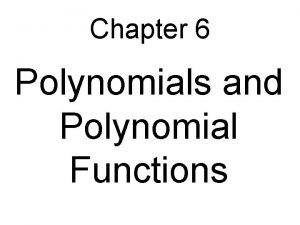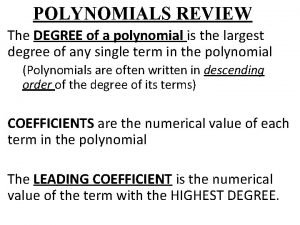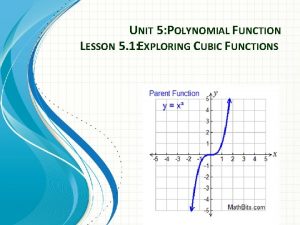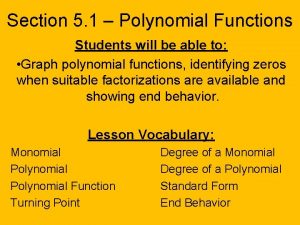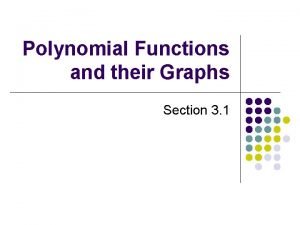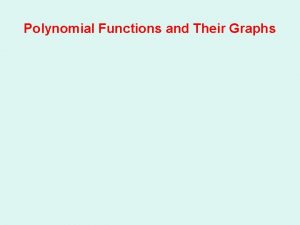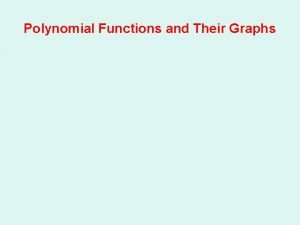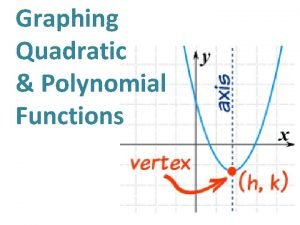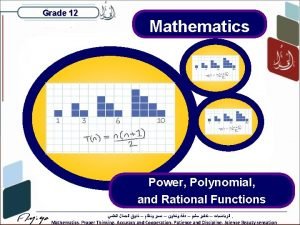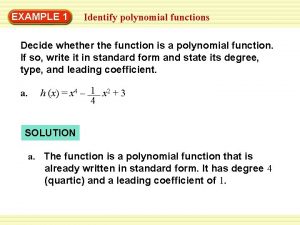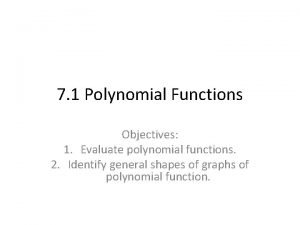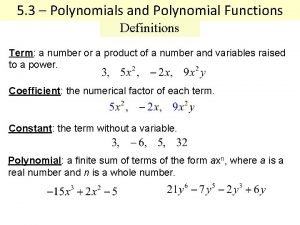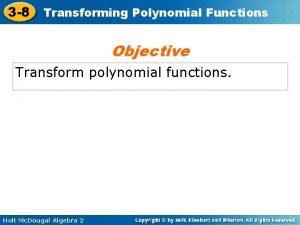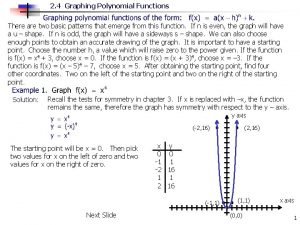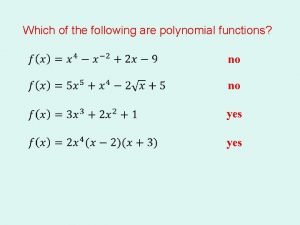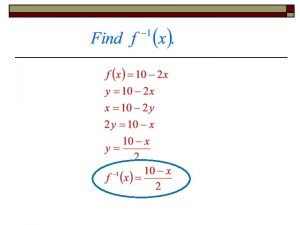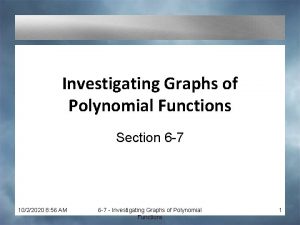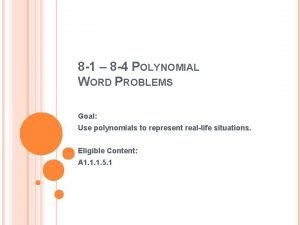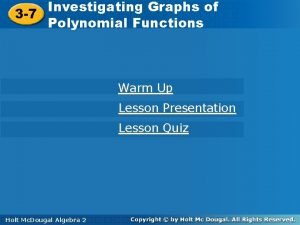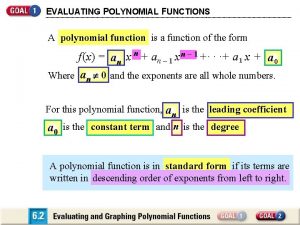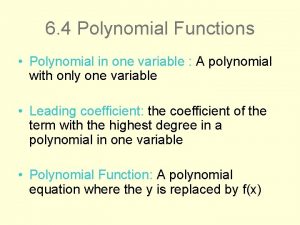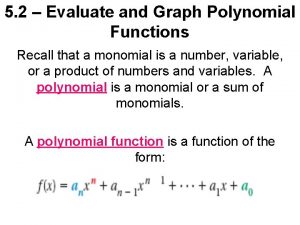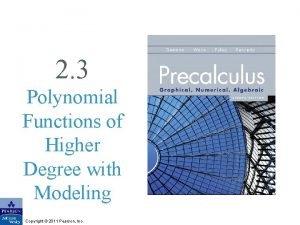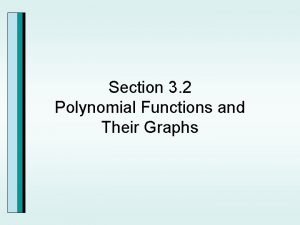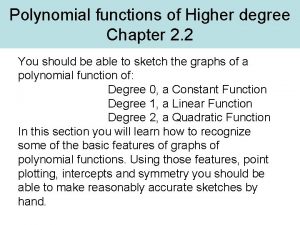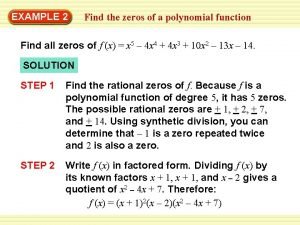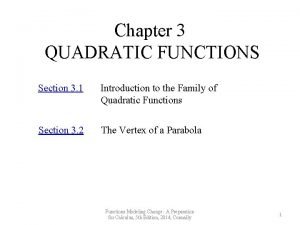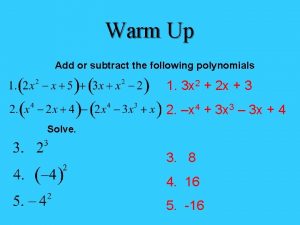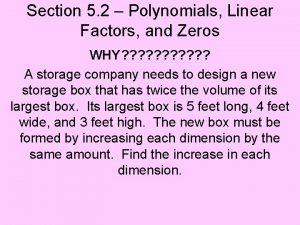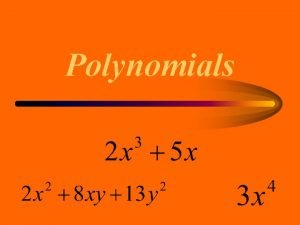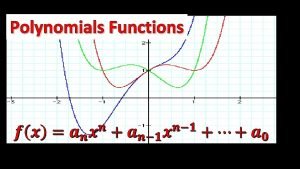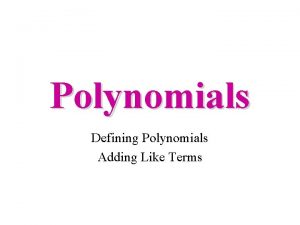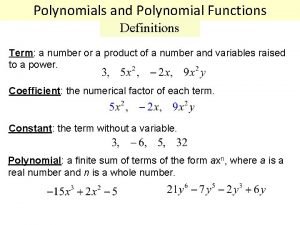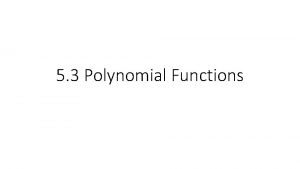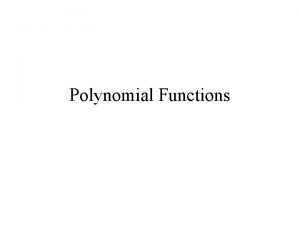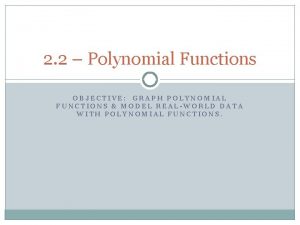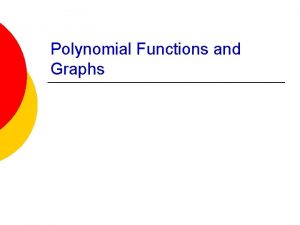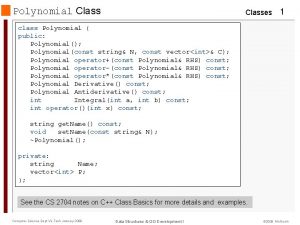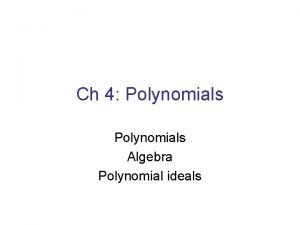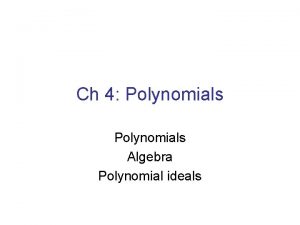Chapter 8 Polynomials Section 8 1 Polynomial Functions










































































- Slides: 74

Chapter 8 Polynomials Section 8. 1 Polynomial Functions Section 8. 2 Expressions and Polynomial Functions Section 8. 3 Solving Polynomial Equations Section 8. 4 Long-Run Behavior of Polynomial Functions ALGEBRA: FORM AND FUNCTION 2 nd edition by Mc. Callum, Connally, Hughes-Hallett, et al. , Copyright 2015, John Wiley & Sons, Inc.

8. 1 Polynomial Functions Section 8. 1 ALGEBRA: FORM AND FUNCTION 2 nd edition by Mc. Callum, Connally, Hughes-Hallett, et al. , Copyright 2015, John Wiley & Sons, Inc.

Have you ever wondered how your calculator works? The electronic circuits inside a calculator can perform only the basic operations of arithmetic. But what about the square-root button, or the ex button? How can a calculator evaluate expressions like or e− 0. 6? The answer is that some calculators use special built-in formulas that return excellent approximations for or ex. These formulas require only simple arithmetic, so they can be written using only the low-level instructions understood by computer chips. So what can we do using only the simple arithmetic operations of addition and multiplication? Section 8. 1 ALGEBRA: FORM AND FUNCTION 2 nd edition by Mc. Callum, Connally, Hughes-Hallett, et al. , Copyright 2015, John Wiley & Sons, Inc.

Example 1 a The expression 0. 042 x 4 + 0. 167 x 3 + 0. 5 x 2 + x + 1 can be used to approximate the values of ex. (a) Show that this expression gives a good estimate for the value of e 0. 5 and e− 0. 6. Solution (a) We have 0. 042(0. 5)4 + 0. 167(0. 5)3 + 0. 5(0. 5)2 + (0. 5) + 1 = 1. 6485, whereas e 0. 5 = 1. 6487, so the expression 0. 042 x 4 + 0. 167 x 3 + 0. 5 x 2 + x + 1 gives an excellent approximation of ex at x = 0. 5. Likewise, 0. 042(− 0. 6)4 + 0. 167(− 0. 6)3 + 0. 5(− 0. 6)2 + (− 0. 6) + 1 = 0. 5494, whereas e− 0. 6 = 0. 5488. Once again, the approximation is good. Section 8. 1 ALGEBRA: FORM AND FUNCTION 2 nd edition by Mc. Callum, Connally, Hughes-Hallett, et al. , Copyright 2015, John Wiley & Sons, Inc.

Example 1 b The expression 0. 042 x 4 + 0. 167 x 3 + 0. 5 x 2 + x + 1 can be used to approximate the values of ex. (b) What operations are used in evaluating these two estimates? Solution (b) Although the expression 0. 042 x 4 + 0. 167 x 3 + 0. 5 x 2 + x + 1 looks more complicated than ex, it is simpler in one important way. You can calculate the values of the expression using only multiplication and addition. For instance, at x = 0. 5, the first two terms are 0. 042 x 4 = 0. 042(0. 5)4 = (0. 042)(0. 5)(0. 5) = 0. 002625 3 = 0. 167(0. 5)3 = (0. 167)(0. 5)(0. 5) = 0. 020875. 0. 167 x The other terms are calculated in a similar way, then added together. The same comments apply at x = − 0. 6. Section 8. 1 ALGEBRA: FORM AND FUNCTION 2 nd edition by Mc. Callum, Connally, Hughes-Hallett, et al. , Copyright 2015, John Wiley & Sons, Inc.

Approximation Formulas Used by Calculators The techniques used by a calculator to approximate the value of expressions like ex are more complicated than the one we have shown here. However, the basic principle is the same: the calculator uses only basic operations. Section 8. 1 ALGEBRA: FORM AND FUNCTION 2 nd edition by Mc. Callum, Connally, Hughes-Hallett, et al. , Copyright 2015, John Wiley & Sons, Inc.

How Good Is Our Approximation Formula Although our formula for approximating ex works reasonably well for values of x = 0. 5 and x = − 0. 6, it works less well for other values. Figure 8. 1 shows graphs of y = ex and the expression we used to approximate it. Notice that the two graphs are quite close in the general vicinity of x = 0. 5 and x = − 0. 6. However, for other values of x, the two graphs draw farther apart. This means that we cannot rely on our formula for all values of x. Figure 8. 1: The graphs are close near x = 0. 5 and x = − 0. 6 but draw farther apart as we zoom out Section 8. 1 ALGEBRA: FORM AND FUNCTION 2 nd edition by Mc. Callum, Connally, Hughes-Hallett, et al. , Copyright 2015, John Wiley & Sons, Inc.

What Is a Polynomial? The expression in Example 1 is formed by adding together the terms 0. 042 x 4, 0. 167 x 3, 0. 5 x 2, x, and 1, which is the sum of five monomials and is an example of a polynomial. Every term of the expression is of the form kxn (even 1, which is equal to kxn with k = 1 and n = 0). . A monomial in x is an expression of the form kxn, where k is a constant (non-zero) and n is a whole number (positive or zero). A polynomial in x is an expression that is equivalent to a sum of monomials in x. Section 8. 1 ALGEBRA: FORM AND FUNCTION 2 nd edition by Mc. Callum, Connally, Hughes-Hallett, et al. , Copyright 2015, John Wiley & Sons, Inc.

Example 2 Which of the following are monomials in x? Solution (a) This is a monomial with k = − 1/9 and n = 2. (b) This is not a monomial because (c) This is a monomial with (d) A monomial cannot have expressions like 7 x, where the variable appears in the exponent. (e) This is not a monomial because it is not of the form kxn. (f) This is not a monomial because x appears in the denominator. If we write this as 7 x− 3, we see that k = 7 and n = − 3, and n is a negative integer. Section 8. 1 ALGEBRA: FORM AND FUNCTION 2 nd edition by Mc. Callum, Connally, Hughes-Hallett, et al. , Copyright 2015, John Wiley & Sons, Inc.

Example 3 abc Which of the following are polynomials in x? (b) 5 Solution (a) This is a polynomial. Writing it as we see that it is the sum of three monomials, namely, x 2, 3 x 4 and −x/3. (b) This is a polynomial because it can be written as 5 x 0. (c) This is not a polynomial because it has a term in and 1/2 is not a whole number. Section 8. 1 ALGEBRA: FORM AND FUNCTION 2 nd edition by Mc. Callum, Connally, Hughes-Hallett, et al. , Copyright 2015, John Wiley & Sons, Inc.

Example 3 def Which of the following are polynomials in x? (d) 9 · 2 x + 4 · 3 x + 15 x Solution (d) While a polynomial can have whole number powers of x (like x 2 or x 3), it cannot have expressions like 2 x, where the variable appears in the exponent. (e) This is a polynomial because it is equivalent to a sum of monomials: (x − 2)(x − 4) = x 2 − 4 x − 2 x + 8 = x 2 − 6 x + 8. (f) This is not a polynomial because x appears in the denominator. If we write this as we see that one of the operations is raising x to a negative power. Section 8. 1 ALGEBRA: FORM AND FUNCTION 2 nd edition by Mc. Callum, Connally, Hughes-Hallett, et al. , Copyright 2015, John Wiley & Sons, Inc.

Polynomial Functions Just as a linear function is one defined by a linear expression, and a quadratic function is one defined by a quadratic expression, a polynomial function is a function of the form y = p(x) = Polynomial in x. Example 4 A box is 4 ft longer than it is wide and twice as high as it is wide. Express the volume of the box as a polynomial function of the width. Solution Let w be the width of the box in feet, and let V be its volume in cubic feet. Then its length is w + 4, and its height is 2 w, so V = w(w + 4)(2 w) = 2 w 2(w + 4) = 2 w 3 + 8 w 2. Section 8. 1 ALGEBRA: FORM AND FUNCTION 2 nd edition by Mc. Callum, Connally, Hughes-Hallett, et al. , Copyright 2015, John Wiley & Sons, Inc.

Example 5 A deposit of $800 is made into a bank account with an annual interest rate of r. Express B, the balance after 4 years, as a polynomial function of r. Solution Each year the balance is multiplied by 1 + r, so at the end of four years we have B = 800(1 + r)4. This is probably the most convenient form for the expression describing this function. However, by expanding and collecting like terms, we could express it as a sum of terms involving powers up to r 4, namely, B = 800 + 3200 r + 4800 r 2 + 3200 r 3 + 800 r 4. We do this in Problem 27 in the problem set. Section 8. 1 ALGEBRA: FORM AND FUNCTION 2 nd edition by Mc. Callum, Connally, Hughes-Hallett, et al. , Copyright 2015, John Wiley & Sons, Inc.

Example 6 Which of the following describe polynomial functions? (a) The surface area of a cylinder of radius R and fixed height h is f(R) = 2πRh + 2 πR 2. (b) The balance on a deposit P after t years in a bank account with an annual interest rate of r is B(t) = P(1 + r)t. (c) The effective potential energy of a sun-planet system is a function of the distance r between the planet and the sun given by g(r) = − 3 r − 1 + r − 2. Solution (a) This is a polynomial function because it is expressed as a sum of a constant times R plus another constant times R 2. (b) Although this function looks similar to the one in Example 5, the situation is different because here r is a constant not the independent variable. This is not a polynomial function because the independent variable occurs in the exponent. (c) This is not a polynomial because r appears to a negative power. Section 8. 1 ALGEBRA: FORM AND FUNCTION 2 nd edition by Mc. Callum, Connally, Hughes-Hallett, et al. , Copyright 2015, John Wiley & Sons, Inc.

8. 1 POLYNOMIAL FUNCTIONS Key Points • Identifying polynomial expressions • Making approximations using polynomials Section 8. 1 ALGEBRA: FORM AND FUNCTION 2 nd edition by Mc. Callum, Connally, Hughes-Hallett, et al. , Copyright 2015, John Wiley & Sons, Inc.

8. 2 Expressions and Polynomial Functions Section 8. 2 ALGEBRA: FORM AND FUNCTION 2 nd edition by Mc. Callum, Connally, Hughes-Hallett, et al. , Copyright 2015, John Wiley & Sons, Inc.

The Degree of a Polynomials are classified by the highest power of x in them. • Linear expressions b + mx are polynomials whose highest power, 1, occurs in the term x 1 = x, • Quadratic expressions ax 2 + bx + c are polynomials whose highest power, 2, occurs in x 2. We call these linear polynomials and quadratic polynomials respectively. • Cubic polynomials are next in line, and can be written ax 3 + bx 2 + cx + d. • Quartic polynomials have a term in x 4, • Quintic polynomials, with a term in x 5. The highest power of the variable occurring in the polynomial is called the degree of the polynomial. Section 8. 2 ALGEBRA: FORM AND FUNCTION 2 nd edition by Mc. Callum, Connally, Hughes-Hallett, et al. , Copyright 2015, John Wiley & Sons, Inc.

Example 1 Give the degree of (a) 4 x 5 − x 3 + 3 x 2 + x + 1 (c) (1 − x)(1 + x 2)2 (b) 9 − x 3 − x 2 + 3(x 3 − 1) (d) − 1 Solution (a) The polynomial 4 x 5 − x 3 + 3 x 2 + x + 1 is of degree 5 because the term with the highest power is 4 x 5. (b) Expanding and collecting like terms, we have 9 − x 3 − x 2 + 3(x 3 − 1) = 9 − x 3 − x 2 + 3 x 3 − 3 = 2 x 3 − x 2 + 6, so this is a polynomial of degree 3. (c) Expanding and collecting like terms, we have (1 − x)(1 + x 2)2 = (1 − x)(1 + 2 x 2 + x 4) = 1 + 2 x 2 + x 4 − x − 2 x 3 − x 5 = −x 5 + x 4 − 2 x 3 + 2 x 2 − x + 1, so this is a polynomial of degree 5. (d) Because − 1 can be written as (− 1)x 0, it is a polynomial of degree 0. Section 8. 2 ALGEBRA: FORM AND FUNCTION 2 nd edition by Mc. Callum, Connally, Hughes-Hallett, et al. , Copyright 2015, John Wiley & Sons, Inc.

Example 2 Every year on his birthday Elliot’s parents invest money for him at an annual interest rate of r, starting with $500 on his 15 th birthday, $600 on his 16 th, and going up by $100 each year after that. (a) If r = 4%, what is his investment worth on his 21 st birthday? (b) If x = 1 + r, then x is the annual growth factor. Write a polynomial in x for the value of his investment on his 21 st birthday. (c) Find the degree of the polynomial and interpret it in terms of the investment. Solution (a) On his 21 st birthday the investment is worth the sum of all of the birthday presents plus interest. The first gift of $500 has been earning interest for 6 years, and so is worth $500(1. 04)6 = $632. 66. The second gift of $600 has been earning interest for 5 years, so it is worth $600(1. 04)5 = $729. 99, and so on. Adding up all the gifts, we get Total value = 500(1. 04)6 + 600(1. 04)5 + 700(1. 04)4 + 800(1. 04)3 +900(1. 04)2 + 1000(1. 04)+ 1100 = $6194. 88. (b) Replacing 1. 04 by x, we get Total value = 500 x 6 + 600 x 5 + 700 x 4 + 800 x 3 + 900 x 2 + 1000 x + 1100. (c) Since the term with the highest power is 500 x 6, the degree is 6. The first present has been earning interest for 6 years, so it has been multiplied by x six times. Section 8. 2 ALGEBRA: FORM AND FUNCTION 2 nd edition by Mc. Callum, Connally, Hughes-Hallett, et al. , Copyright 2015, John Wiley & Sons, Inc.

The Standard Form of a Polynomial We get the standard form of a polynomial by expanding and collecting like terms. Since a polynomial can have a large number of coefficients, we number them using subscripts, like this: Degree of polynomial Standard form 1 a 1 x + a 0 2 a 2 x 2 + a 1 x + a 0 3 a 3 x 3 + a 2 x 2 + a 1 x + a 0 4 a 4 x 4 + a 3 x 3 + a 2 x 2 + a 1 x + a 0 5 a 5 x 5 + a 4 x 4 + a 3 x 3 + a 2 x 2 + a 1 x + a 0 4 is a , the coefficient of x 3 is a , and so on. The coefficient of x 4 3 Notice that a 0 is the coefficient of x 0 = 1, and therefore a 0 is the constant term. Section 8. 2 ALGEBRA: FORM AND FUNCTION 2 nd edition by Mc. Callum, Connally, Hughes-Hallett, et al. , Copyright 2015, John Wiley & Sons, Inc.

Example 3 Identify the coefficients of (a) 2 x 3 + 3 x 2 + 4 x − 1 (b) 4 x 5 − x 3 + 3 x 2 + x + 1 (c) x 2. Solution (a) The subscript of the coefficient should match up with the power of x, so 2 x 3 + 3 x 2 + 4 x − 1 = a 3 x 3 + a 2 x 2 + a 1 x + a 0. Thus, a 3 = 2, a 2 = 3, a 1 = 4, and a 0 = − 1. (b) Writing this as 4 x 5 − x 3 + 3 x 2 + x + 1 = 4 x 5 + 0 · x 4 + (− 1)x 3 + 3 x 2 + 1 · x 1 + 1 · x 0, we see that it has coefficients a 5 = 4, a 4 = 0, a 3 = − 1, a 2 = 3, a 1 = 1, a 0 = 1. (c) Writing this as x 2 = 1 · x 2 + 0 · x + 0, we get a 2 = 1, a 1 = 0, and a 0 = 0. Section 8. 2 ALGEBRA: FORM AND FUNCTION 2 nd edition by Mc. Callum, Connally, Hughes-Hallett, et al. , Copyright 2015, John Wiley & Sons, Inc.

Polynomials of Degree n We sometimes use a letter, such as n, to represent the degree of a polynomial. So n is the highest power in the polynomial, and the coefficient of the corresponding term is written an. Example 4 Consider the polynomial 13 x 17 − 9 x 16 + 4 x 14 + 3 x 2 + 7. (a) What is the degree, n? (b) Write out the terms anxn and an− 1 xn− 1. (c) What is the value of an− 3? (d) What is the value of a 1? Solution (a) The degree is n = 17. (b) Since n = 17, then an is the coefficient of x 17, so an = 13. Likewise, an− 1 is the coefficient of xn− 1 = x 16, so an− 1 = − 9. n 17 n− 1 = − 9 x 16. Therefore, a nx = 13 x and an− 1 x (c) The degree is n = 17, so an− 3 = a 14 is the coefficient of x 14, which means that an− 3 = 4. (d) Since a 1 is the coefficient of x, and there is no x-term, a 1 = 0. Section 8. 2 ALGEBRA: FORM AND FUNCTION 2 nd edition by Mc. Callum, Connally, Hughes-Hallett, et al. , Copyright 2015, John Wiley & Sons, Inc.

The Standard Form of a Polynomial The standard form of a polynomial in x is p(x) = anxn + an− 1 xn− 1 + ・ ・ ・ + a 1 x + a 0, where n is a non-negative integer and a 0, a 1, . . . , an are constants. • The constants a 0, a 1, . . . , an are the coefficients. • If an ≠ 0, then n is the degree of the polynomial, and an is the leading coefficient. The constant term a 0 gives the value of a polynomial at x = 0: n + a n− 1 + · · · + a · 0 + a = a. p(0) = a · 0 n n− 1 1 0 0 Section 8. 2 ALGEBRA: FORM AND FUNCTION 2 nd edition by Mc. Callum, Connally, Hughes-Hallett, et al. , Copyright 2015, John Wiley & Sons, Inc.

The Constant Term Example 5 Give the constant term of (a) 4 − x 3 − x 2 (b) z 3 + z 2 (c) (q − 1)(q − 2)(q − 3). Solution (a) Writing this as −x 3 − x 2 + 4, we see that its constant term is a 0 = 4. (b) Since the only two terms in this polynomial involve positive powers of z, it has constant term a 0 = 0. (c) We could calculate the constant term of this polynomial by expanding it out. However, since we know that the constant term is the value of the polynomial when q = 0, we can say that a 0 = (0 − 1)(0 − 2)(0 − 3) = (− 1)(− 2)(− 3) = − 6. Section 8. 2 ALGEBRA: FORM AND FUNCTION 2 nd edition by Mc. Callum, Connally, Hughes-Hallett, et al. , Copyright 2015, John Wiley & Sons, Inc.

The Constant Term (continued) The constant term tells us the vertical intercept of the graph of p. Example 6 Which of Figures 8. 2 and 8. 3 is the graph of p(x) = x 4 − 4 x 3 + 16 x − 16? Solution Since p(0) = − 16, we choose the graph that appears to intercept the y-axis at around y = − 16, Figure 8. 3. Figure 8. 2: A quartic polynomial Figure 8. 3: A quartic polynomial Section 8. 2 ALGEBRA: FORM AND FUNCTION 2 nd edition by Mc. Callum, Connally, Hughes-Hallett, et al. , Copyright 2015, John Wiley & Sons, Inc.

Example 7 Find the constant term of the polynomial 800(1 + r)4 in Example 5 from section 8. 1, and interpret it in terms of interest rates. Solution The polynomial gives the bank balance 4 years after an initial deposit of $800. Although we have not expanded this polynomial, we know that the constant term is the value when r = 0, so Constant term = 800(1 + 0)4 = 800. This is the value of the bank balance after 4 years if the interest rate is 0. It makes sense that this is the same as the initial deposit, since if the interest rate is 0 the balance does not grow or shrink. Section 8. 2 ALGEBRA: FORM AND FUNCTION 2 nd edition by Mc. Callum, Connally, Hughes-Hallett, et al. , Copyright 2015, John Wiley & Sons, Inc.

The Leading Term and Leading Coefficient We already know that all first-degree polynomials have graphs that are lines, and all second-degree polynomials have graphs that are parabolas. This suggests that polynomials of the same degree have certain features in common and that the term with the highest power plays an important role in the overall behavior of a polynomial function. In a polynomial anxn + an− 1 xn− 1 + · · · + a 1 x + a 0, with an ≠ 0, the highest-power term anxn is called the leading term of the polynomial. The coefficient, an, of the leading term is called the leading coefficient of the polynomial. Section 8. 2 ALGEBRA: FORM AND FUNCTION 2 nd edition by Mc. Callum, Connally, Hughes-Hallett, et al. , Copyright 2015, John Wiley & Sons, Inc.

The Leading Term and Leading Coefficient (continued) Example 8 Give the degree and leading term of (a) s − 3 s 3 + s 2 Solution (a) The degree is 3, and the leading term is − 3 s 3. (b) We could expand this out to find the leading term, but it is not necessary. The highest degree term comes from multiplying the leading terms from each factor, giving Thus, the degree is 3 and the leading term is Section 8. 2 ALGEBRA: FORM AND FUNCTION 2 nd edition by Mc. Callum, Connally, Hughes-Hallett, et al. , Copyright 2015, John Wiley & Sons, Inc.

Example 9 ab If p(x) has degree 4 and constant term − 2, and q(x) has degree 5 and constant term 7, what can we say about (a) The degree of p(x)q(x)? (b) The coefficient of x in p(x)q(x)? Solution (a) When we multiply two polynomials together, the leading term in the product comes from multiplying together the leading terms in each factor. The leading term in p(x) is a constant times x 4 and the leading term in q(x) is a constant times x 5, so the leading term in p(x)q(x) is a constant times x 4 · x 5 = x 9. Thus the degree of p(x)q(x) is 9. (b) We do not have enough information: to know the coefficient of x in p(x)q(x) we would need to know more about the coefficients in p(x) and q(x). Section 8. 2 ALGEBRA: FORM AND FUNCTION 2 nd edition by Mc. Callum, Connally, Hughes-Hallett, et al. , Copyright 2015, John Wiley & Sons, Inc.

Example 9 cde If p(x) has degree 4 and constant term − 2, and q(x) has degree 5 and constant term 7, what can we say about (c) The degree of p(x) + q(x)? (d) The constant term of 3 p(x) − 2 q(x)? (e) The degree of p(x)2, that is, (p(x))? Solution (c) Since p(x) has terms only up to degree 4, the leading term in p(x) + q(x) is the term in x 5 coming from q(x), so the degree is 5. (d) The constant terms in p(x) and q(x) are the only terms contributing to the constant term in 3 p(x) − 2 q(x), so that term is 3(− 2) − 2 · 7 = − 20. (e) When we multiply p(x) by itself, the highest-degree term comes from 4, times itself, the highest degree of p(x), which is a constant times x giving a constant times x 8. Thus the degree of p(x)2 is 8. Section 8. 2 ALGEBRA: FORM AND FUNCTION 2 nd edition by Mc. Callum, Connally, Hughes-Hallett, et al. , Copyright 2015, John Wiley & Sons, Inc.

Example 10 Consider the polynomial (ax 3 + 1)2 − x 6, where a is a constant. (a) What is the leading term? (b) For what values of a is the degree less than 6? Solution (a) One approach would be to place this polynomial in standard form. However, we can determine the leading term with fewer steps as follows: (ax 3 + 1)2 − x 6 = (ax 3)2 + lower-order terms − x 6 = a 2 x 6 − x 6 + lower-order terms = (a 2 − 1)x 6 + lower-order terms. So the leading term is (a 2 − 1)x 6. (b) Notice that for most values of a, the degree of the polynomial is 6. However, the term (a 2− 1)x 6 disappears if a 2 − 1 = 0, that is, if a = ± 1. Therefore, for these values of a, the degree is less than 6. Section 8. 2 ALGEBRA: FORM AND FUNCTION 2 nd edition by Mc. Callum, Connally, Hughes-Hallett, et al. , Copyright 2015, John Wiley & Sons, Inc.

Summary • The standard form for a polynomial in x is anxn + an− 1 xn− 1 + ・ ・ ・ + a 1 x + a 0, an ≠ 0. • Here, n is called the degree of the polynomial and is the power of the highest-power term or leading term. • The coefficients are a 0, a 1, . . . , an− 1, and an. • The coefficient a 0 is also called the constant term. It determines the value of the expression at x = 0. • Special categories of polynomials include (in order of increasing degree) linear, quadratic, cubic, quartic, and quintic. Section 8. 2 ALGEBRA: FORM AND FUNCTION 2 nd edition by Mc. Callum, Connally, Hughes-Hallett, et al. , Copyright 2015, John Wiley & Sons, Inc.

8. 2 Expressions and Polynomial Functions Key Points • The standard form of a polynomial • Identifying the degree, leading term and constant term of a polynomial Section 8. 2 ALGEBRA: FORM AND FUNCTION 2 nd edition by Mc. Callum, Connally, Hughes-Hallett, et al. , Copyright 2015, John Wiley & Sons, Inc.

8. 3 Solving Polynomial Equations Section 8. 3 ALGEBRA: FORM AND FUNCTION 2 nd edition by Mc. Callum, Connally, Hughes-Hallett, et al. , Copyright 2015, John Wiley & Sons, Inc.

A polynomial equation is an equation in which the expressions on both sides are polynomials. As with quadratic equations, we can sometimes solve polynomial equations by factoring, using the zero-factor principle. Example 1 Solve x 2 = x 3. Solution We subtract x 3 from both sides and factor: x 2 − x 3 = 0 x 2(1 − x) = 0. For the expression on the left to be zero, one of the factors x 2 or 1 − x must be zero, so x = 0 or x = 1. Notice that we cannot solve this equation by dividing both sides by x 2, because x 2 could be zero. Doing this would leave only the solution x = 1, missing the solution x = 0. Section 8. 3 ALGEBRA: FORM AND FUNCTION 2 nd edition by Mc. Callum, Connally, Hughes-Hallett, et al. , Copyright 2015, John Wiley & Sons, Inc.

Example 2 Solve w 3 − 2 w − 1 = (w + 1)3. Solution Expanding the right-hand side, w 3 − 2 w − 1 = w 3 + 3 w 2 + 3 w + 1 w 3 − 2 w − 1 − w 3 − 3 w 2 − 3 w − 1 = 0 subtract right side from both sides − 3 w 2 − 5 w − 2 = 0 collect like terms (w 3 terms cancel) 3 w 2 + 5 w + 2 = 0 multiply both sides by − 1 (3 w + 2)(w + 1) = 0, factor the left side, so the solutions are w = − 2/3, w = − 1. Section 8. 3 ALGEBRA: FORM AND FUNCTION 2 nd edition by Mc. Callum, Connally, Hughes-Hallett, et al. , Copyright 2015, John Wiley & Sons, Inc.

Example 3 Show that 2 and 3 are the only consecutive positive integers such that the cube of the first is 1 less than the square of the second. Solution If we have two consecutive numbers, say n and n + 1, such that the cube of the first, n 3, is one less than the square of the second, (n + 1)2, then we have the polynomial equation n 3 = (n + 1)2 − 1. Solving this equation gives n 3 = n 2 + 2 n + 1 − 1 n 3 − n 2 − 2 n = 0 n(n + 1)(n − 2) = 0. The solutions are n = 0, n = − 1, and n = 2. The only positive integer solution is n = 2, so the only pair of consecutive positive integers with this property is n = 2, n + 1 = 3. In the previous examples we converted the equation to the form p(x) = 0. For a polynomial p(x), the solutions to p(x) = 0 are called the zeros of the polynomial. Section 8. 3 ALGEBRA: FORM AND FUNCTION 2 nd edition by Mc. Callum, Connally, Hughes-Hallett, et al. , Copyright 2015, John Wiley & Sons, Inc.

Finding Zeros by Graphing It is not always easy to factor a polynomial of degree greater than 2. Graphing the polynomial to see where it is zero can help us find approximate zeros, or to guess an exact zero. Example 4 Solve p(x) = 2 x 3 + x 2 − 12 x + 9 = 0 by graphing the polynomial, p(x). Solution In Figure 8. 4, the graph of p(x) crosses the x-axis at approximately x = − 3, x = 1, and x = 3/2. Figure 8. 4: Graph of p(x) = 2 x 3 + x 2 − 12 x + 9 (Continued on next slide. ) Section 8. 3 ALGEBRA: FORM AND FUNCTION 2 nd edition by Mc. Callum, Connally, Hughes-Hallett, et al. , Copyright 2015, John Wiley & Sons, Inc.

Finding Zeros by Graphing Example 4 (continued) Solve p(x) = 2 x 3 + x 2 − 12 x + 9 = 0 by graphing the polynomial, p(x). Solution In Figure 8. 4, the graph of p(x) crosses the x-axis at approximately x = − 3, x = 1, and x = 3/2, so these are approximate solutions to p(x) = 0. To test whether they are exact solutions, we evaluate p(− 3) = 2(− 3)3 + (− 3)2 − 12(− 3) + 9 = − 54 + 9 + 36 + 9 = 0 p(1) = 2(1)3 + (1)2 − 12(1) + 9 = 2 + 1 − 12 + 9 = 0 p(3/2) = 2(3/2)3 + (3/2)2 – 12(3/2) + 9 = 27/4 +9/4 -18 + 9 = 0 so all three are exact solutions. In the next subsection we see why they are the only solutions. Section 8. 3 ALGEBRA: FORM AND FUNCTION 2 nd edition by Mc. Callum, Connally, Hughes-Hallett, et al. , Copyright 2015, John Wiley & Sons, Inc.

The Relation between Factors and Zeros We have seen how to find zeros from factors. For example, if p(x) = (x − 5)(x 2 + 2 x + 4) then p(5) = 0(52 + 2 · 5 + 4) = 0. Finding Zeros from Factors If p(x) = (x − k) · (Other factors), then p(k) = 0 · (Another number) = 0, so x = k is a zero of p(x) Section 8. 3 ALGEBRA: FORM AND FUNCTION 2 nd edition by Mc. Callum, Connally, Hughes-Hallett, et al. , Copyright 2015, John Wiley & Sons, Inc.

Example 5 Find a polynomial that has degree 4 and has zeros at t = − 1, t = 0, t = 1 and t = 2. Solution We can make the polynomial have the zeros we want by choosing the right factors. A factor of t − (− 1) = t + 1 will make it have a zero at t = − 1, a factor of t − 0 = t will make it have a zero at t = 0, and factors t − 1 and t − 2 will make it have zeros at t = 1 and t = 2. Multiplying these factors we get the degree 4 polynomial p(t) = t(t + 1)(t − 2). Section 8. 3 ALGEBRA: FORM AND FUNCTION 2 nd edition by Mc. Callum, Connally, Hughes-Hallett, et al. , Copyright 2015, John Wiley & Sons, Inc.

The Relation between Factors and Zeros It turns out that not only do factors give zeros, but zeros give factors: Finding Factors from Zeros If a polynomial has a zero at x = k, then it has a factor (x − k). We can use it to factor polynomials if we already know their zeros. Section 8. 3 ALGEBRA: FORM AND FUNCTION 2 nd edition by Mc. Callum, Connally, Hughes-Hallett, et al. , Copyright 2015, John Wiley & Sons, Inc.

Example 6 Factor the polynomial p(x) in Example 4. Solution We know p(x) has zeros x = − 3, 1, and 3/2, so it must have factors x − k, where k = − 3, 1, or 3/2, that is, x − (− 3) = x + 3, x − 1, and x − 3/2. Multiplying these together we get Multiplying all the coefficients on the right-hand side by 2 gives the coefficients of p(x), so p(x) = 2(x + 3)(x − 1)(x − 3/2) = (x + 3)(x − 1)(2 x − 3). Section 8. 3 ALGEBRA: FORM AND FUNCTION 2 nd edition by Mc. Callum, Connally, Hughes-Hallett, et al. , Copyright 2015, John Wiley & Sons, Inc.

How Many Zeros Can a Polynomial Have? A polynomial cannot have more factors than its degree. For example, a fourth-degree polynomial cannot have more than four factors, because if it did then the highest power of x would be greater than four when we multiplied the factors out. Since each zero of a polynomial corresponds to a factor, the number of zeros cannot be more than the degree of the polynomial. It is possible, however, for the number of zeros to be less than the degree. Section 8. 3 ALGEBRA: FORM AND FUNCTION 2 nd edition by Mc. Callum, Connally, Hughes-Hallett, et al. , Copyright 2015, John Wiley & Sons, Inc.

Example 7 Without solving, say how many solutions each equation could have. (a) x 4 + x 3 − 3 x 2 − 2 x + 2 = 0 (b) 3(x 3 − x) = 1 + 3 x 3 (c) (s 2 + 5)(s − 3) = 0 Solution (a) Since the degree of the polynomial on the left is 4, the equation can have at most 4 solutions. (b) This looks as if it could simplify to an equation of the form p(x) = 0, where p(x) is a cubic polynomial, so there would be up to 3 solutions. However, the leading term on both sides is 3 x 3, so when we simplify, the leading terms cancel, leaving only the linear term. Thus the equation can only have one solution. (c) The polynomial on the left is a cubic, so there could be up to 3 solutions. However, the quadratic factor, s 2 +5, cannot have any zeros because it is 5 plus a square, so it is always positive. Thus, there is only one solution, coming from the linear factor. Section 8. 3 ALGEBRA: FORM AND FUNCTION 2 nd edition by Mc. Callum, Connally, Hughes-Hallett, et al. , Copyright 2015, John Wiley & Sons, Inc.

Multiple Zeros Sometimes the factor of a polynomial is repeated, as in or In this case we say the zero is a multiple zero. For instance, we say that x = 4 is a double zero of (x − 4)2, and x = − 1 is a triple zero of (x + 1)3. If a zero is not repeated, we call it a simple zero. Section 8. 3 ALGEBRA: FORM AND FUNCTION 2 nd edition by Mc. Callum, Connally, Hughes-Hallett, et al. , Copyright 2015, John Wiley & Sons, Inc.

Visualizing the Zeros of a Polynomial The polynomial p(x) = x 3 − x 2 − 6 x factors as p(x) = x(x − 3)(x + 2), and so has zeros at x = − 2, x = 0, and x = 3. Since there are no repeated factors, these are all simple zeros. Figure 8. 5 shows the graph of y = p(x) crossing the x-axis at these zeros. In general, the graph of a polynomial crosses the axis at a simple zero. Figure 8. 5: Graph of y = x 3 − x 2 − 6 x Section 8. 3 ALGEBRA: FORM AND FUNCTION 2 nd edition by Mc. Callum, Connally, Hughes-Hallett, et al. , Copyright 2015, John Wiley & Sons, Inc.

What Does the Graph Look Like at Multiple Zeros? The graph of (x − 4)2 in Figure 8. 6 show typical behavior near double zeros. Here the graph touches, but does not cross, the horizontal axis at the double zero x = 4. This behavior is typical of the graph of (x − k)n for even n: the graph of the polynomial does not cross the x-axis at x = k, but “bounces” off the x-axis at x = k. Figure 8. 6: Double zero at x = 4 Section 8. 3 ALGEBRA: FORM AND FUNCTION 2 nd edition by Mc. Callum, Connally, Hughes-Hallett, et al. , Copyright 2015, John Wiley & Sons, Inc.

What Does the Graph Look Like at Multiple Zeros? The graph of (x - 2)3 in Figure 8. 7 show typical behavior near triple zeros. Here the graph crosses the horizontal axis at the triple zero x = 2 but is flattened there compared to a simple zero (see Figure 8. 5). This behavior is typical of the graph of (x − k)n for odd n: the graph of the polynomial crosses the x-axis at x = k, but it looks flattened there. Figure 8. 7: Triple zero at x = 2 Section 8. 3 ALGEBRA: FORM AND FUNCTION 2 nd edition by Mc. Callum, Connally, Hughes-Hallett, et al. , Copyright 2015, John Wiley & Sons, Inc.

The Appearance of the Graph at a Multiple Zero Suppose that the polynomial p(x) has a multiple zero at x = k that occurs exactly n times, so p(x) = (x − k)n · (Other factors), n ≥ 2. • If n is even, the graph of the polynomial does not cross the x-axis at x = k, but “bounces” off the x-axis at x = k. (See Figure 8. 6. ) • If n is odd, the graph of the polynomial crosses the x-axis at x = k, but it looks flattened there. (See Figure 8. 7. ) Figure 8. 6: Double zero at x = 4 Figure 8. 7: Triple zero at x = 2 Section 8. 3 ALGEBRA: FORM AND FUNCTION 2 nd edition by Mc. Callum, Connally, Hughes-Hallett, et al. , Copyright 2015, John Wiley & Sons, Inc.

Example 8 a Describe in words the zeros of the polynomials of degree 4 graphed in Figure 8. 8: Polynomials of degree 4 Solution (a) The first graph has two x-intercepts, one at x = − 2 and one at x = 2. The flattened appearance near x = 2 suggests that the polynomial has a multiple zero there. Since the graph crosses the x-axis at x = 2 (instead of bouncing off it), the corresponding factor must occur an odd number of times. Since the polynomial is of degree 4, we conclude there is a triple zero at x = 2 and a simple zero at x = − 2. Section 8. 3 ALGEBRA: FORM AND FUNCTION 2 nd edition by Mc. Callum, Connally, Hughes-Hallett, et al. , Copyright 2015, John Wiley & Sons, Inc.

Example 8 bc Describe in words the zeros of the polynomials of degree 4 graphed in Figure 8. 8: Polynomials of degree 4 Solution (b) The second graph has four x-intercepts, corresponding to four simple zeros. We know none of the zeros are repeated because the polynomial is degree 4. (c) The third graph has three x-intercepts at x = 0, x = 3, and x = − 2. The graph crosses the axis at x = 0 and x = 3, so they are simple zeros. The graph bounces at x = − 2, so this is a double zero of the polynomial. It is not a higherorder zero (such as a quadruple zero) because the polynomial is only of degree 4. Section 8. 3 ALGEBRA: FORM AND FUNCTION 2 nd edition by Mc. Callum, Connally, Hughes-Hallett, et al. , Copyright 2015, John Wiley & Sons, Inc.

A Connection between Polynomials and Decimal Notation We can think of an integer written in decimal notation as a polynomial expression involving a sum of powers of ten (as opposed to powers of a variable like x). Example 9 a (a) Use the fact that 3000 + 700 + 20 = 3720 to find a solution to the equation 3 x 3 + 7 x 2 + 2 x = 3720. Solution (a) We can rewrite 3000 + 700 + 20 = 3720 as 3 · 103 + 7 · 102 + 2 · 101 + 0 · 100 = 3720. This means that the equation 3 x 3 + 7 x 2 + 2 x = 3720 has a solution at x = 10. Consequently, the polynomial 3 x 3 + 7 x 2 + 2 x − 3720 has a zero at x = 10. Section 8. 3 ALGEBRA: FORM AND FUNCTION 2 nd edition by Mc. Callum, Connally, Hughes-Hallett, et al. , Copyright 2015, John Wiley & Sons, Inc.

A Connection between Polynomials and Decimal Notation Example 9 b (b) What does your answer tell you about the factors of the polynomial 3 x 3 + 7 x 2 + 2 x − 3720? Solution (b) We know (x − 10) must be a factor. In fact, 3 x 3 + 7 x 2 + 2 x − 3720 = (x − 10)(3 x 2 + 37 x + 372). How did we find the factor 3 x 2 + 37 x + 372 on the right-hand side? We used polynomial long division, which is analogous to ordinary long division of integers. Section 8. 3 ALGEBRA: FORM AND FUNCTION 2 nd edition by Mc. Callum, Connally, Hughes-Hallett, et al. , Copyright 2015, John Wiley & Sons, Inc.

8. 3 SOLVING POLYNOMIAL EQUATIONS Key Points • Finding zeros of a polynomial by factoring • The relationship between zeros and factors of a polynomial • The number of zeros a polynomial can have • Identifying zeros of a polynomial from a graph • The graph of a polynomial that has multiple zeros Section 8. 3 ALGEBRA: FORM AND FUNCTION 2 nd edition by Mc. Callum, Connally, Hughes-Hallett, et al. , Copyright 2015, John Wiley & Sons, Inc.

8. 4 Long-Run Behavior of Polynomial Functions Section 8. 4 ALGEBRA: FORM AND FUNCTION 2 nd edition by Mc. Callum, Connally, Hughes-Hallett, et al. , Copyright 2015, John Wiley & Sons, Inc.

Example 1 Describe how the features of the graph of f(x) = x 3 + x 2 change when zooming out. Solution In Figure 8. 9, we see that the graph of f has two x-intercepts and two bumps. In Figure 8. 10, we zoom out to show the same function on a larger viewing window. Here, the bumps are no longer apparent, nor is the fact that there are two xintercepts. Figure 8. 9: On this scale, we see that the graph of y = x 3 + x 2 has two bumps and two x-intercepts Section 8. 4 Figure 8. 10: On this scale, some features of the graph of y = x 3 + x 2 are no longer apparent. ALGEBRA: FORM AND FUNCTION 2 nd edition by Mc. Callum, Connally, Hughes-Hallett, et al. , Copyright 2015, John Wiley & Sons, Inc.

The Importance of the Leading Term When we zoom out from a graph, as in Example 1, we turn our attention to values of the polynomial for large (positive or negative) values of x. Although every term in a polynomial contributes to its value, we see in Example 2 that for large enough values of x, the leading term’s contribution can be more important than the contributions of all the other terms combined. Example 2 Show that, provided the value of x is large enough, the value of the term 4 x 5 in the polynomial p(x) = 4 x 5 − x 3 + 3 x 2 + x + 1 is far larger than the value of the other terms combined. Solution To see this, we let x = 100. Then 4 x 5 = 4(100)5 = 40, 000, 000. On the other hand, the value of the other terms combined is −x 3 + 3 x 2 + x + 1 = −(100)3 + 3(100)2 + 100 + 1 = − 1, 000 + 30, 000 + 1 = − 969, 899. (Solution continued on next slide. ) Section 8. 4 ALGEBRA: FORM AND FUNCTION 2 nd edition by Mc. Callum, Connally, Hughes-Hallett, et al. , Copyright 2015, John Wiley & Sons, Inc.

The Importance of the Leading Term (continued) Example 2 (continued) Solution Therefore, at x = 100, the combined value is = 39, 999, 030, 101. Thinking in terms of money, the value of 4 x 5 by itself is $40 billion, whereas if we include the other terms the combined value is $39. 999 billion. Comparing these two values, the difference is negligible, even though (by itself) $969, 899 is a lot of money. Hence, for large values of x, p(x) ≈ 4 x 5. Section 8. 4 ALGEBRA: FORM AND FUNCTION 2 nd edition by Mc. Callum, Connally, Hughes-Hallett, et al. , Copyright 2015, John Wiley & Sons, Inc.

In general, if the value of x is large enough, we can give a reasonable approximation for a polynomial’s value by ignoring or neglecting the lower-degree terms. Consequently, when viewed on a large enough scale, the graph of the polynomial function y = anxn + an− 1 xn− 1 + · · · + a 1 x + a 0 strongly resembles the graph of the power function y = anxn, and we say that the long-run behavior of the polynomial is given by its leading term. The Long-Run Behavior of a Polynomial n n− 1 + · · · + a x + a , with a ≠ 0, the leading In a polynomial a nx + an− 1 x 1 0 n term anxn determines the polynomial’s long-run behavior. Section 8. 4 ALGEBRA: FORM AND FUNCTION 2 nd edition by Mc. Callum, Connally, Hughes-Hallett, et al. , Copyright 2015, John Wiley & Sons, Inc.

Example 3 Find a window in which the graph of y = x 3 + x 2 resembles the graph of its leading term y = x 3. Solution Figure 8. 11 gives the graphs of y = x 3 +x 2 and y = x 3. On this scale, y = x 3 + x 2 does not look like a power. On the larger scale in Figure 8. 12, the graph of y = x 3 + x 2 resembles the graph of y = x 3. On this larger scale, the “bumps” in the graph of y = x 3 + x 2 are too small to be seen. On an even larger scale, as in Figure 8. 13, the graph of y = x 3 + x 2 is nearly indistinguishable from the graph of y = x 3. Figure 8. 11: On this scale, Figure 8. 12: On this scale, Figure 8. 13: On this scale, y = x 3 + x 2 does not look like y = x 3 + x 2 resembles the y = x 3 + x 2 is nearly a power function y = x 3 indistinguishable from y = x 3 Section 8. 4 ALGEBRA: FORM AND FUNCTION 2 nd edition by Mc. Callum, Connally, Hughes-Hallett, et al. , Copyright 2015, John Wiley & Sons, Inc.

Example 3 (continued) Solution (continued) (Continued 1) (Enlarged Figure 8. 11. ) Figure 8. 11: On this scale, y = x 3 + x 2 does not look like a power function Section 8. 4 ALGEBRA: FORM AND FUNCTION 2 nd edition by Mc. Callum, Connally, Hughes-Hallett, et al. , Copyright 2015, John Wiley & Sons, Inc.

Example 3 (continued) Solution (continued) (Continued 2) (Enlarged Figure 8. 12. ) Figure 8. 12: On this scale, y = x 3 + x 2 resembles the power function y = x 3 Section 8. 4 ALGEBRA: FORM AND FUNCTION 2 nd edition by Mc. Callum, Connally, Hughes-Hallett, et al. , Copyright 2015, John Wiley & Sons, Inc.

Example 3 (continued) Solution (continued) (Continued 3) (Enlarged Figure 8. 13. ) Figure 8. 13: On this scale, y = x 3 + x 2 is nearly indistinguishable from y = x 3 Section 8. 4 ALGEBRA: FORM AND FUNCTION 2 nd edition by Mc. Callum, Connally, Hughes-Hallett, et al. , Copyright 2015, John Wiley & Sons, Inc.

Since the long-run behavior of a polynomial is given by its leading term, polynomials with the same leading term have similar graphs on a large scale. However, they can look quite different on a small scale. Example 4 Compare the graphs of the polynomial functions f(x) = x 4 − 4 x 3 + 16 x − 16, g(x) = x 4 − 4 x 3 − 4 x 2 + 16 x, h(x) = x 4 + x 3 − 8 x 2 − 12 x. Solution Since each of these polynomials has x 4 as its leading term, all their graphs resemble the graph of x 4 on a large scale. See Figure 8. 14. On a smaller scale, the polynomials look different. See Figure 8. 15. Two of the graphs go through the origin while third does not. The graphs also differ from one another in the number of bumps each one has and in the number of times each one crosses the x-axis. (See next slide for Figure 8. 14 and Figure 8. 15. ) Section 8. 4 ALGEBRA: FORM AND FUNCTION 2 nd edition by Mc. Callum, Connally, Hughes-Hallett, et al. , Copyright 2015, John Wiley & Sons, Inc.

Example 4 (continued) Compare the graphs of the polynomial functions f(x) = x 4 − 4 x 3 + 16 x − 16, g(x) = x 4 − 4 x 3 − 4 x 2 + 16 x, h(x) = x 4 + x 3 − 8 x 2− 12 x. Solution Figure 8. 14: On a large scale, the three polynomials resemble the power y = x 4 Figure 8. 15: On a smaller scale, the three polynomials look quite different from each other Section 8. 4 ALGEBRA: FORM AND FUNCTION 2 nd edition by Mc. Callum, Connally, Hughes-Hallett, et al. , Copyright 2015, John Wiley & Sons, Inc.

Interpreting the Leading Term in Mathematical Models Example 5 The box described in Example 4 in Section 8. 1 has width w, length w + 4, height 2 w, and volume V = w(w + 4)(2 w) = 2 w 3 + 8 w 2. Find the leading term of this polynomial and give a practical interpretation of it. Solution The leading term is 2 w 3. This represents the approximate volume of the box when w is large. To see this, suppose the box is relatively small, having width w = 2 ft. Then Volume = 2 · 6 · 4 = 48 ft 3 Leading term = 2 · 23 = 16 ft 3. Here, the leading term does not give a good approximation to the volume. But now imagine an enormous box—a giant warehouse, say—having width w = 1000 ft. Then Volume = 1000 · 1004 · 2000 = 2, 008, 000 ft 3 Leading term = 2 · 10003 = 2, 000, 000 ft 3 (Solution continued on next slide. ) Section 8. 4 ALGEBRA: FORM AND FUNCTION 2 nd edition by Mc. Callum, Connally, Hughes-Hallett, et al. , Copyright 2015, John Wiley & Sons, Inc.

Example 5 (continued) Solution (continued) Volume = 1000 · 1004 · 2000 = 2, 008, 000 ft 3 Leading term = 2 · 10003 = 2, 000, 000 ft 3. We see that the true volume, 2. 008 billion ft 3, is only slightly larger than the approximation of 2 billion ft 3 provided by the leading term. Unlike the small box, whose width is just a fraction of its length (2 ft versus 6 ft), the width of the large box is almost the same as its length (1000 ft versus 1004 ft). This means and because width and height are close = w · 2 w = 2 w 3, so Volume ≈ Leading term. Section 8. 4 ALGEBRA: FORM AND FUNCTION 2 nd edition by Mc. Callum, Connally, Hughes-Hallett, et al. , Copyright 2015, John Wiley & Sons, Inc.

Finding a Possible Formula for a Polynomial Function from Its Graph Example 6 Find a possible formula for the polynomial f(x) graphed in Figure 8. 16: Find a formula for this polynomial Solution Based on its large-scale shape, which is similar in appearance to y = −x 3, the degree of f(x) is odd and is larger than 1. Note that, judging from the shape alone, we cannot be sure the degree is 3; a fifth-degree polynomial might have the same general long-run appearance. But we do know the degree is not 1 (otherwise the graph would be a straight line). (Solution continued on next slide. ) Section 8. 4 ALGEBRA: FORM AND FUNCTION 2 nd edition by Mc. Callum, Connally, Hughes-Hallett, et al. , Copyright 2015, John Wiley & Sons, Inc.

Example 6 (continued) Figure 8. 16: Find a formula for this polynomial Solution (continued) The graph has x-intercepts at x = − 1 and x = 3. We see that x = 3 is a multiple zero of even power, because the graph bounces off the x-axis here instead of crossing it. Therefore, a possible formula is f(x) = k(x + 1)(x − 3)2, k a non-zero constant. which has degree 3 and agrees with our previous observation. To find k, we note that the y-intercept of the graph tells us f(0) = − 3, so f(0) = k(0 + 1)(0 − 3)2 = − 3, which gives 9 k = − 3 so k = − 1/3. Thus, f(x) = (− 1/3) (x + 1)(x − 3)2 is a possible formula for this polynomial function. Section 8. 4 ALGEBRA: FORM AND FUNCTION 2 nd edition by Mc. Callum, Connally, Hughes-Hallett, et al. , Copyright 2015, John Wiley & Sons, Inc.

The Constant k If we had not accounted for the constant k in Example 6, we would have obtained the formula y = (x + 1)(x − 3)2. Although this function has the right zeros (at x = − 1 and a double zero at x = 3), it has the wrong long-run behavior: On large scales, its graph more closely resembles y = x 3, not y = −x 3. Although other choices of k lead to graphs similar to Figure 8. 16, only one value of k yields the correct y-intercept. For instance, the function y = − 0. 5(x + 1)(x − 3)2 3. But has the right zeros and in the long run resembles y = − 0. 5 x its y-intercept is y = − 4. 5, not y = − 3. Section 8. 4 ALGEBRA: FORM AND FUNCTION 2 nd edition by Mc. Callum, Connally, Hughes-Hallett, et al. , Copyright 2015, John Wiley & Sons, Inc.

Example 7 a Consider the polynomial q(x) = 3 x 6 − 2 x 5 + 4 x 2 − 1. (a) What does the leading term tell us about the graph? Solution (a) The leading term is 3 x 6, so on a large scale, the graph of y = 3 x 6 − 2 x 5 + 4 x 2 − 1 looks like y = 3 x 6. (See Figure 8. 17. ) This means that this function takes on large positive values as x grows large (either positive or negative). Figure 8. 17: Graph must cross x-axis at least twice since 3 x 6 − 2 x 5 + 4 x 2 − 1 looks like 3 x 6 for large x, and 3 x 6 − 2 x 5 + 4 x 2 − 1 = − 1 when x = 0. Section 8. 4 ALGEBRA: FORM AND FUNCTION 2 nd edition by Mc. Callum, Connally, Hughes-Hallett, et al. , Copyright 2015, John Wiley & Sons, Inc.

Example 7 bc Consider the polynomial q(x) = 3 x 6 − 2 x 5 + 4 x 2 − 1. (b) What does the constant term tell us about the graph? (c) What do the answers to (a) and (b) tell us about the number of solutions to q(x) = 0? Solution (b) The constant term is − 1. This tells us that the graph crosses the y-axis at y = − 1, which is below the x-axis. (c) The equation 3 x 6 − 2 x 5 +4 x 2 − 1 = 0 must have at least two solutions. We know this because the graph of y = 3 x 6 − 2 x 5 + 4 x 2 − 1 is smooth and unbroken, so it must cross the x-axis at least twice to get from its yintercept of y = − 1 to the positive values it attains as x grows larger in both the positive and negative directions. Note that a sixth-degree polynomial can have as many as six real zeros, or none at all. For instance, the sixth-degree polynomial x 6 + 1 has no zeros, because its value is always greater than or equal to 1. Section 8. 4 ALGEBRA: FORM AND FUNCTION 2 nd edition by Mc. Callum, Connally, Hughes-Hallett, et al. , Copyright 2015, John Wiley & Sons, Inc.

8. 4 Long-Run Behavior of Polynomial Functions Key Points • Long-run behavior of a polynomial is determined by the leading term • Finding a formula for a polynomial from its graph Section 8. 4 ALGEBRA: FORM AND FUNCTION 2 nd edition by Mc. Callum, Connally, Hughes-Hallett, et al. , Copyright 2015, John Wiley & Sons, Inc.
 End behavior of a function chart
End behavior of a function chart Review of polynomials and polynomial functions
Review of polynomials and polynomial functions Chapter 4 polynomial and rational functions
Chapter 4 polynomial and rational functions Chapter 3 polynomial and rational functions
Chapter 3 polynomial and rational functions Chapter 3 polynomial and rational functions
Chapter 3 polynomial and rational functions Matplotlib inline
Matplotlib inline How to divide a polynomial by another polynomial
How to divide a polynomial by another polynomial Polynomial closure property
Polynomial closure property Unit 5: polynomial functions homework 3
Unit 5: polynomial functions homework 3 Structure in graphs of polynomial functions
Structure in graphs of polynomial functions 5-1 polynomial functions
5-1 polynomial functions Constant polynomial
Constant polynomial Quadratic function leading coefficient
Quadratic function leading coefficient I can recognize polynomial function yes or no
I can recognize polynomial function yes or no Investigating graphs of polynomial functions
Investigating graphs of polynomial functions Investigating graphs of functions for their properties
Investigating graphs of functions for their properties Polynomial end behavior chart
Polynomial end behavior chart Graphing of polynomial function
Graphing of polynomial function Rational equations
Rational equations How to identify a polynomial
How to identify a polynomial Practice 6-2 polynomials and linear factors
Practice 6-2 polynomials and linear factors Evaluating polynomial function
Evaluating polynomial function Transforming polynomial functions quiz part one
Transforming polynomial functions quiz part one 5-3 skills practice polynomial functions
5-3 skills practice polynomial functions Odd degree polynomial end behavior
Odd degree polynomial end behavior Polynomial function transformations
Polynomial function transformations (-2 4) graph
(-2 4) graph Which of the following are polynomial functions?
Which of the following are polynomial functions? Closure properties of integers and polynomials
Closure properties of integers and polynomials Polynomial equation real life examples
Polynomial equation real life examples Polynomial functions of higher degree
Polynomial functions of higher degree 6-7 investigating graphs of polynomial functions
6-7 investigating graphs of polynomial functions Polynomial word problems worksheet
Polynomial word problems worksheet 5-4 analyzing graphs of polynomial functions
5-4 analyzing graphs of polynomial functions How to find slant asymptotes
How to find slant asymptotes Analyzing graphs of polynomial functions calculator
Analyzing graphs of polynomial functions calculator 6-7 investigating graphs of polynomial functions
6-7 investigating graphs of polynomial functions Evaluating polynomial functions
Evaluating polynomial functions Polynomial functions in one variable
Polynomial functions in one variable Evaluate and graph polynomial functions
Evaluate and graph polynomial functions Polynomial functions of higher degree with modeling
Polynomial functions of higher degree with modeling Polynomial functions and their graphs
Polynomial functions and their graphs Polynomial functions of higher degree
Polynomial functions of higher degree Power function end behavior model
Power function end behavior model Lesson 5-2 graphing polynomial functions answers
Lesson 5-2 graphing polynomial functions answers Polynomial threshold functions
Polynomial threshold functions 5-4 practice analyzing graphs of polynomial functions
5-4 practice analyzing graphs of polynomial functions 5-1 polynomial functions
5-1 polynomial functions Chapter 10 section 1 meiosis worksheet answer key
Chapter 10 section 1 meiosis worksheet answer key Piecewise functions absolute value
Piecewise functions absolute value I can evaluate functions
I can evaluate functions Evaluating functions and operations on functions
Evaluating functions and operations on functions Calculus 3
Calculus 3 Revolved section view
Revolved section view Removed section definition
Removed section definition Half sectioning
Half sectioning Work and energy section 2 describing energy
Work and energy section 2 describing energy Add/subtract the following polynomials
Add/subtract the following polynomials Polynomials in healthcare
Polynomials in healthcare Negative and positive tic tac toe chart
Negative and positive tic tac toe chart Lagrange polynomials
Lagrange polynomials Polynomials, linear factors, and zeroes
Polynomials, linear factors, and zeroes Leading coefficient of polynomial
Leading coefficient of polynomial Multiplying polynomials vocabulary
Multiplying polynomials vocabulary Polynomials
Polynomials Polynomial written in standard form
Polynomial written in standard form Polynomial binomial trinomial
Polynomial binomial trinomial How to subtract polynomials
How to subtract polynomials Polynomial classification
Polynomial classification How do you know if a polynomial is in standard form
How do you know if a polynomial is in standard form Multiplying polynomials using algebra tiles
Multiplying polynomials using algebra tiles Lesson 7-7 multiplying polynomials answers
Lesson 7-7 multiplying polynomials answers (q+6)(q+5)
(q+6)(q+5) Orthogonal series expansion
Orthogonal series expansion Syntheic divison
Syntheic divison
